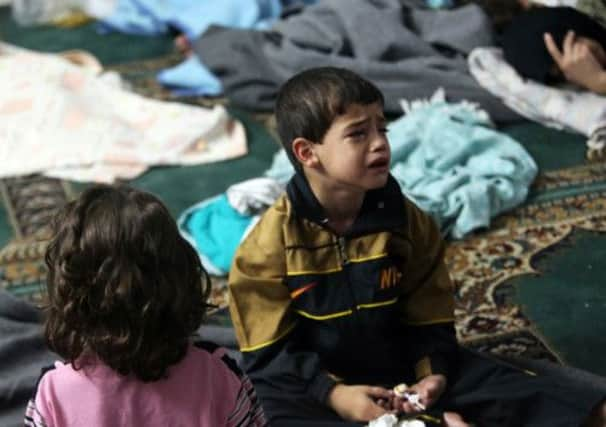Syria: Rocket footage ‘adds more pieces to puzzle’


The unverified images show members of the Syrian Republican Guard preparing to fire from the west of Damascus towards Ghouta, the eastern area targeted in last week’s bombardment.
Although the material will increase pressure on the Assad regime, it does not offer any evidence of chemical warfare payload being deployed.
Advertisement
Hide AdAdvertisement
Hide AdMunitions experts said the footage – which has been circulated widely on social networking sites – added “more pieces to the puzzle”.
It is understood the video was first posted on the Facebook page of a group calling itself the Darya Revolution. It claims it shows the launch of a rocket with chemical weapons from Mezzeh military airport.
Nic Jenzen-Jones, a munitions specialist and security analyst who has studied the footage, said it was not possible to identify the type of munition that was used. But he said the video suggested it was fired from an Iranian Falaq-2 launcher, or a copy of one.
“The rocket in the video is a strong match for the type of munitions documented in Daraya, Khaladiya, Yabroud, Adra, Eastern Ghouta and Zamalka,” he said on his Rogue Adventurer blog.
“The video shows several men around the launch site wearing red berets, which is apparently typical of the uniform worn by the Syrian Republican Guard. This is consistent with reports from Israeli sources that rockets containing chemical agents were fired by the 155th Brigade, 4th Armoured Division, which is closely aligned with the Republican Guard. Both units are commanded by Syrian president Bashar al-Assad’s brother, Maher al-Assad.”
He added: “Whilst we certainly do not have enough information to positively identify the munition featured in the Mezzeh airport launch video just yet, we can say that (i) it is likely a non-standard munition produced in Iran or Syria, not widely used or manufactured, but likely not an ‘improvised’ munition [and] (ii) it is a tube-launched munition, fired from an Iranian Falaq-2 launcher or copy.
“Of course, whilst none of this material constitutes explicit evidence of a CW [chemical weapons] strike by Assad’s forces – that’s a question for the UN team – it does add more pieces to the puzzle, and documents the use of a recently unknown munition in conjunction with an Iranian type launcher, purportedly by Syrian government forces.”
Another analyst, Eliot Higgins, who runs the Brown Moses blog, said the people who shot the video had been in touch and told him: “This is fired from the areas to the east and north-east of al-Mezzeh airport.”
Regime ‘using prisoners as human shields’
Advertisement
Hide AdAdvertisement
Hide AdSyrian authorities are reported to have moved prisoners out of their cells and into installations the government believes could be targets of western military strikes.
Residents in Damascus said they had seen fully loaded buses moving late on Wednesday from the military court in the capital to Mezzeh air base on the south-western tip of the city, a likely target for US missiles.
The plight of thousands of prisoners held in security facilities across the country is a major concern for their families and opposition activists. There are chilling echoes of the Iraq War ,when Saddam Hussain used civilians as human shields.
“People are really scared about the prisoners’ safety, and that the US will attack places where the prisoners are held,” one pro-democracy activist said. “They are afraid because military bases are in built-up areas, so civilians may be caught in the attacks.
“There is a lot of fear that prisoners will take the brunt of the attacks, and they have all seen the civilians killed by US forces in Iraq and Afghanistan.”
The opposition Syrian National Coalition also said prisoners were being used as human shields. “Assad’s fascist regime is amassing detained activists and civilians in prisons inside military locations that may be potential targets for foreign military forces,” it said.
“Using civilians as human shields is a blatant breach of International Humanitarian Law, and those responsible must be held accountable for crimes against humanity.”
Thousands of protesters, rebels and dissidents have been arrested and held in detention since the start of the uprising in March 2011. Many remain missing and are believed to be inside a shadowy network of security or military compounds.
Advertisement
Hide AdAdvertisement
Hide AdThe Syrian authorities have never allowed independent international organisations to inspect detention centres run by feared secret police units. Human rights organisations say torture is endemic.
Bracing for possible western military strikes, residents of Damascus have been stocking up on food, water and fuel. Many stayed away from work yesterday, opting instead to join the queues at petrol stations and bakeries.